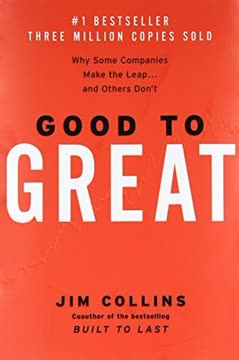Key Takeaways
1. Great leaders significantly outperform good leaders in measurable outcomes
"The difference between really great leaders and the others is extraordinary."
Quantifiable impact. Research shows that leaders in the top 10% of effectiveness ratings produce twice the net revenue compared to average leaders. This translates to significant improvements in various organizational outcomes:
- Profitability: Top leaders generate nearly double the profits of average leaders
- Employee retention: Extraordinary leaders reduce turnover by 5% compared to good leaders
- Customer satisfaction: The best leaders achieve customer satisfaction ratings 30 percentile points higher than average leaders
- Employee engagement: 57% of employees working for top leaders are highly committed, compared to only 13% for the worst leaders
Beyond incremental gains. The relationship between leadership effectiveness and outcomes is not linear. Small improvements in leadership ability do not necessarily lead to better results. To achieve significant gains, leaders must move from good to great, typically reaching the 80th percentile or higher in effectiveness ratings.
2. Strengths, not weaknesses, define extraordinary leadership
"Great leaders are not defined by the absence of weakness, but rather by the presence of clear strengths."
Strength-based approach. The research reveals that focusing on developing strengths is far more effective than trying to fix weaknesses:
- Leaders with no strengths are rated at the 34th percentile in overall effectiveness
- One profound strength moves a leader to the 64th percentile
- Three strengths catapult a leader to the 81st percentile
- Five strengths put a leader in the top 10% of all leaders
Paradigm shift. This insight challenges the conventional wisdom of addressing weaknesses. Instead, organizations and individuals should identify and cultivate existing strengths to achieve extraordinary leadership. This approach is more motivating, leads to faster improvement, and ultimately produces better results.
3. Leadership effectiveness stems from a combination of key competencies
"Leadership behaviors are all knit together, much like the complex network of the human brain."
The leadership tent model. Effective leadership can be visualized as a tent supported by five poles:
- Character (center pole)
- Personal capability
- Focus on results
- Interpersonal skills
- Leading organizational change
Each pole represents a cluster of competencies that work together to create overall leadership effectiveness. The more poles that are raised and the higher they are extended, the greater the leadership impact.
Interconnected competencies. The research identified 16 differentiating competencies that separate the best leaders from the rest. These competencies are not isolated traits but are highly interrelated. Improving one competency often leads to improvements in others, creating a multiplier effect on leadership effectiveness.
4. Powerful combinations of strengths amplify leadership impact
"The combination of strengths ignites a power that catapults a person into the highest realms of effective leadership."
Synergistic effect. When leaders possess complementary strengths, their impact is magnified beyond the sum of individual competencies. For example:
- Leaders strong in both interpersonal skills and results focus have a 72% chance of being in the top 10% of all leaders
- Those strong in only one of these areas have a 14% or lower chance of reaching the top 10%
Strategic development. Leaders should identify and cultivate strengths across different competency clusters to create powerful combinations. This approach leads to more balanced and effective leadership, capable of addressing diverse organizational challenges.
5. Fatal flaws must be addressed to avoid leadership derailment
"If a person is not honorable, does not keep promises, does not tell the truth to people, or if this person places personal gain above the needs of the organization, that flaw will cause the person to be ineffective."
Identify and correct. While the focus should be on developing strengths, certain weaknesses are so detrimental that they must be addressed. The research identified 10 fatal flaws, including:
- Lack of energy and enthusiasm
- Accepting mediocre performance
- Lack of clear vision and direction
- Loss of trust due to poor judgment
- Failure to collaborate and build teams
Targeted intervention. When a fatal flaw is identified, it should be the focus of immediate development efforts. Unlike other weaknesses, these flaws have the potential to completely undermine a leader's effectiveness, regardless of their strengths in other areas.
6. Nonlinear development paths can accelerate leadership growth
"Competencies are not reality but are the perceptions of others about a given leader."
Competency companions. The research uncovered unexpected relationships between competencies, called "competency companions." Improving one competency can lead to perceived improvements in related areas. For example:
- Improving technical expertise is linked to better interpersonal skills
- Enhancing problem-solving abilities is connected to taking more initiative
- Developing others is associated with practicing self-development
Innovative approach. By leveraging these relationships, leaders can find nonobvious ways to improve their perceived effectiveness. This approach often leads to faster and more impactful development than traditional, linear methods focused on directly improving a single competency.
7. Organizational culture and support are crucial for leadership development
"The quality of leadership in an organization seldom exceeds that of the person at the top."
Organizational responsibility. Creating a culture that fosters leadership development is critical. Key elements include:
- Senior executive involvement and modeling of desired behaviors
- A feedback-rich environment that encourages continuous improvement
- Investment in development experiences and opportunities for all employees
- Recognition and celebration of leadership successes
Systemic approach. Leadership development should not be viewed as isolated events but as an ongoing process integrated into the fabric of the organization. This includes providing challenging assignments, mentoring relationships, and opportunities for leaders to teach and develop others.
8. Leadership can be developed through targeted efforts and experiences
"Leaders are made rather than born."
Evidence-based optimism. The research, particularly the case study of the U.S. Marine Corps, demonstrates that leadership can be systematically developed. Key elements of effective leadership development include:
- Focus on practical, job-related learning experiences
- Use of powerful teaching methods that change behavior (e.g., simulations, action learning projects)
- Emphasis on immediate application of new skills and knowledge
- Creation of accountability for implementing new behaviors
Individual responsibility. While organizational support is crucial, individuals must take ownership of their development. The book outlines 25 specific actions leaders can take to improve their effectiveness, such as:
- Identifying and leveraging their strengths
- Seeking feedback and coaching
- Volunteering for challenging assignments
- Studying high performers and replicating their behaviors
- Practicing articulating their vision for the organization
By combining organizational support with individual initiative, extraordinary leadership can be cultivated at all levels of an organization.
Last updated:
Review Summary
The Extraordinary Leader receives mostly positive reviews, with readers praising its research-driven approach to leadership development. Many appreciate the focus on building strengths rather than fixing weaknesses. The book's insights on leadership competencies, character importance, and organizational fit are frequently highlighted. Some readers found the content repetitive or inconsistent, but overall, it's considered a valuable resource for aspiring and current leaders. The book's practical suggestions and challenge to conventional leadership assumptions are widely appreciated.
Similar Books
Download PDF
Download EPUB
.epub digital book format is ideal for reading ebooks on phones, tablets, and e-readers.








